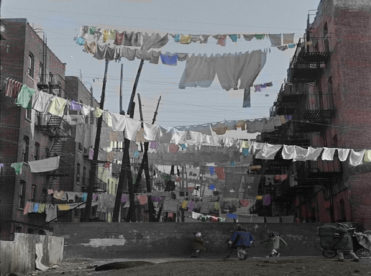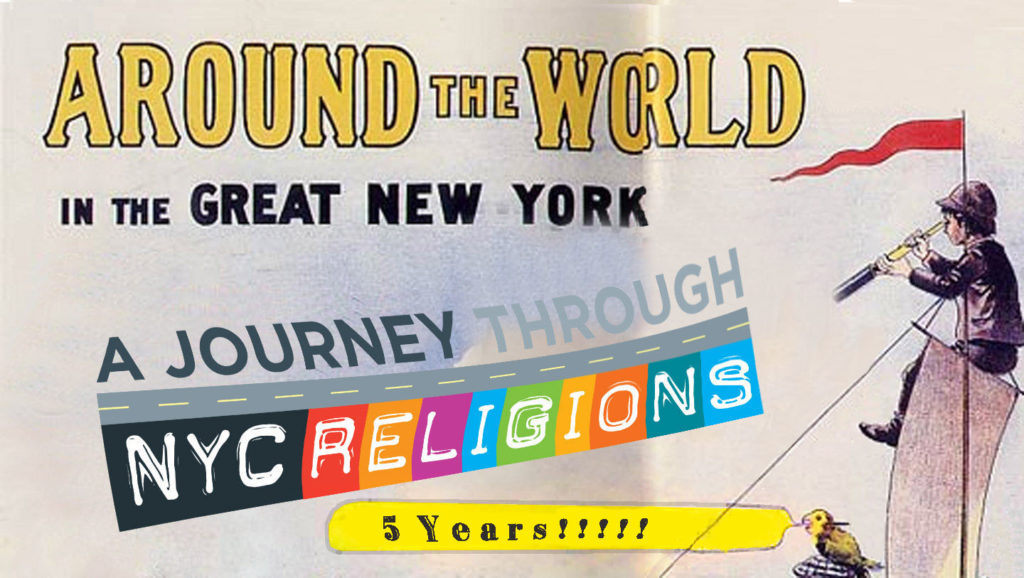
The incompleteness theorem of the art of religion news
The complexity and contradictions of today’s society is why religion news design should aid narrative unity but also reflect the incompleteness and jaggedness of today’s religion stories.
Certainly, story elements can be used to either move the narrative forward, to tell the backstory or put the story into a long-term perspective. WNYC radio’s John Keefe uses design very well to tell a story. In his hands, graphics, photos, and other design elements instantly communicate their place in the narrative headlines.
Lead photo: “If these Bronx clothes could talk!” Illustration by A Journey through NYC religions. Photo: Russell Lee/Library of Congress
However, modern narratives aren’t like they used to be. Modern stories aren’t steady progressions to some certain end. Stories are contradictory, incomplete and subject to fits and starts, sudden reversals and break-offs with no tidy end in sight. Whose story should be told and be given privilege? Religions themselves have contradictory stories as do social scientists.
Story-telling as a paradigm for religion news design is too certain about how everything will wrap up together into a nice package. In fact religion news design that doesn’t take into account the intense interactions, questions and incomplete answers comes to resemble the smooth false certainties of bad church public relations material. The younger audiences reject seamless design and pre-packaged religious narratives.
Some news organizations embrace fragmentation. BuzzFeed’s founder believes fragmentation is the modern condition; the late Circa broke news into atomic particles for random reassembly by readers; Huffington Post and Vice News adapts others’ content to whatever drives traffic. Vox News publishes the equivalent of school note cards summarizing the main points about a news story.
Buzz Feed and its online cousins certainly have won the viewership battle so far. Consequentially, BuzzFeed, Vice and Vox have been able to raise money to expand their outlets and video offerings. These news outlets have also partnered with Youtube in the hopes of producing viral videos and the high revenue associated with television news.
However, there are some contradictions in their methods. Buzz Feed has found that you can’t break a story into fragments unless it had already been assembled into a narrative story. HuffPo too has sped along in the aggregation boat on top of other people’s narrative work. So called “structured journalism” that breaks a news subject down into elemental pieces with links to back stories and explainers usually rely on the audience’s pre-existing narrative sense of the story.
The challenge is great: how do you bricolage religious complexity and contradiction into some sort of comprehensible whole? Various media are trying ways to accomplish this task. Three ways we do this are to admit to the unsolved mysteries to our stories, be attentive to key moments of intense religious, cultural and social disruption and innovation, and to fully engage the complexity and contradictions of our sensory inputs.
The mystery of the city
A writer friend Garnette Cadogan says that more than anything else, New York City contains mysteries. So, religion journalism in the city is at its best when it conveys the discovery of mysteries and the admission that there is much that the reporter does not know.
The more you know about the city, your neighborhood or street, the more that you realize how much you don’t know. Our knowledge is incomplete, contradictory, and surrounded by unknown territories. The city can’t be fully explained: it is exhilarating in that way. There is such joy in traveling the city to discover new things, new faiths, and new ideas.
Fundamentally, the urban mysteries are rooted in the fact that human souls—their minds and hearts—are only partly revealed and always contain unfathomable depths. The real essence of the city is based on the nature of humanity’s soul which has hidden depths, multiplied by demography and history.
Some fear the unknown and lapse into tiresome cliche. The most overworked truism is the idea that the city is a secular place. Maybe that nostrum reassures some of the seculars, but the city is anything but secular: it is the mystery of the soul; the unfathomable depths of the heart; and the complications of infinite number of storylines reaching toward heaven.
The design for religion journalism must capture the mysteries, hint at the unknowns, as well as shining a light upon new revelations.
A few years ago I was breaking bread with the late Rhoda Metreux, who was a noted anthropologist but also well respected for her work for the Office of Strategic Services, the predecessor of the CIA.
She was usually very calm and matter of fact, not given to exclamations. However, she turned to me with an emotionally underlined question, “Do you know what is human-kind’s greatest achievement?”
I was a little surprised by her exclamatory statement, so I just asked back, “What?”
Rhoda looked at me with the superior twinkle that she had when pitying the ignorant. “Secrets!,” she said. “Hiding realities is one of humankind’s greatest achievements.”
In A Tale of Two Cities Charles Dickens claimed, “A wonderful fact to reflect upon, that every human creature is constituted to be that profound secret and mystery to every other. A solemn consideration when I enter a great city by night, that every one of those darkly clustered houses encloses its own secret; that every room in every one of them encloses its own secret; that every beating heart in the hundreds of thousands of breasts there, is, in some of its imaginings, a secret to the heart nearest it!”
Dickens is too conservative: in every beating heart there are multiple mysteries. New York’s 8.3 million hearts contains not just 8.3 million stories, but several times that number—if we only knew!
Religion journalists are methodologically quite concerned with secrets and revelations in their interviews. Often, people will say, “I don’t know anything. Why interview me?” In fact they usually know a lot if one can help them to unlock it. Further, because people are wonderfully complex, every person has interesting things to say about religion.
Who better to explore and portray the mysteries of the city’s souls than a religion reporter?
Next, we will consider the key role of catastrophes, disruptions and innovations in the complexity and contradictions of our sensory inputs from this city.




Leave a Reply